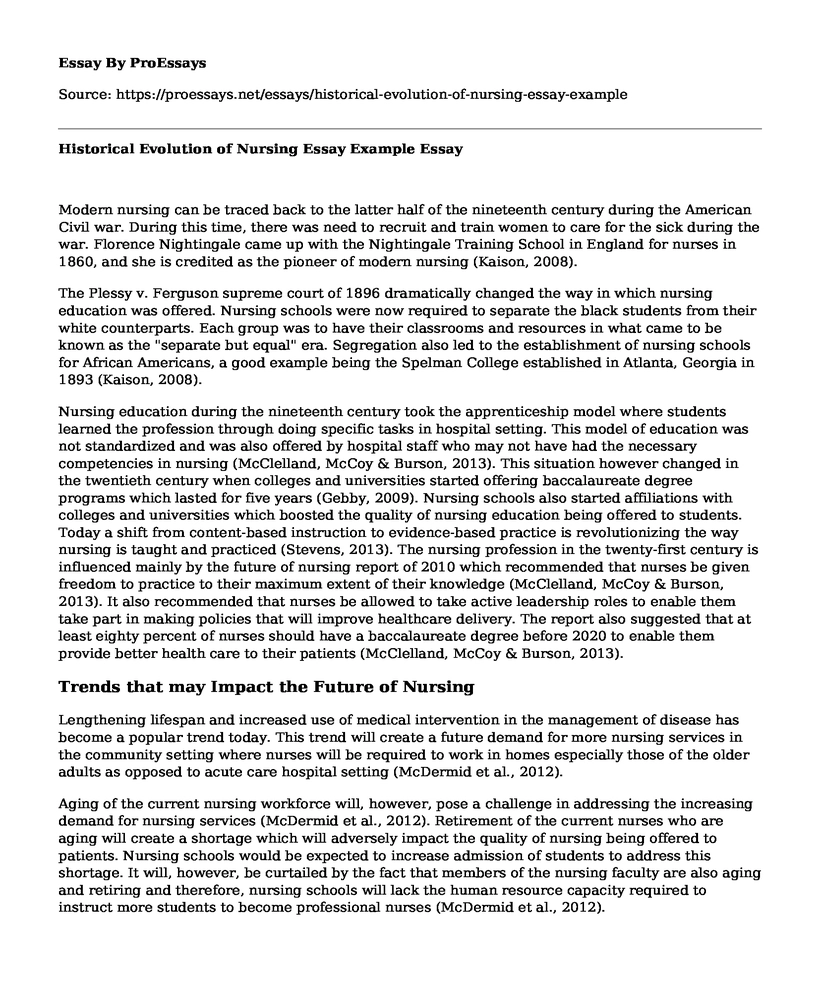Modern nursing can be traced back to the latter half of the nineteenth century during the American Civil war. During this time, there was need to recruit and train women to care for the sick during the war. Florence Nightingale came up with the Nightingale Training School in England for nurses in 1860, and she is credited as the pioneer of modern nursing (Kaison, 2008).
The Plessy v. Ferguson supreme court of 1896 dramatically changed the way in which nursing education was offered. Nursing schools were now required to separate the black students from their white counterparts. Each group was to have their classrooms and resources in what came to be known as the "separate but equal" era. Segregation also led to the establishment of nursing schools for African Americans, a good example being the Spelman College established in Atlanta, Georgia in 1893 (Kaison, 2008).
Nursing education during the nineteenth century took the apprenticeship model where students learned the profession through doing specific tasks in hospital setting. This model of education was not standardized and was also offered by hospital staff who may not have had the necessary competencies in nursing (McClelland, McCoy & Burson, 2013). This situation however changed in the twentieth century when colleges and universities started offering baccalaureate degree programs which lasted for five years (Gebby, 2009). Nursing schools also started affiliations with colleges and universities which boosted the quality of nursing education being offered to students. Today a shift from content-based instruction to evidence-based practice is revolutionizing the way nursing is taught and practiced (Stevens, 2013). The nursing profession in the twenty-first century is influenced mainly by the future of nursing report of 2010 which recommended that nurses be given freedom to practice to their maximum extent of their knowledge (McClelland, McCoy & Burson, 2013). It also recommended that nurses be allowed to take active leadership roles to enable them take part in making policies that will improve healthcare delivery. The report also suggested that at least eighty percent of nurses should have a baccalaureate degree before 2020 to enable them provide better health care to their patients (McClelland, McCoy & Burson, 2013).
Trends that may Impact the Future of Nursing
Lengthening lifespan and increased use of medical intervention in the management of disease has become a popular trend today. This trend will create a future demand for more nursing services in the community setting where nurses will be required to work in homes especially those of the older adults as opposed to acute care hospital setting (McDermid et al., 2012).
Aging of the current nursing workforce will, however, pose a challenge in addressing the increasing demand for nursing services (McDermid et al., 2012). Retirement of the current nurses who are aging will create a shortage which will adversely impact the quality of nursing being offered to patients. Nursing schools would be expected to increase admission of students to address this shortage. It will, however, be curtailed by the fact that members of the nursing faculty are also aging and retiring and therefore, nursing schools will lack the human resource capacity required to instruct more students to become professional nurses (McDermid et al., 2012).
Conclusion
Modern-day nursing has developed from the basic apprenticeship model that was in the early 1860s to the advanced, concept-based profession that it is today. Aging nursing population and faculty, a lengthening lifespan and increased use of medications are some of the factors which affect the future trends in nurses. Efforts should, therefore, be made to ensure that the nursing professions will be adequately prepared to meet the rising nursing demands which will be influenced mainly by the current trends in nursing.
References
Faison, K. (2008). Historical Overview. AJN, American Journal Of Nursing, 108(Supplement), 22. doi: 10.1097/01.naj.0000336405.07130.25
Gebbie, K. (2009). 20th-century reports on nursing and nursing education: What difference did they make?. Nursing Outlook, 57(2), 84-92. doi: 10.1016/j.outlook.2009.01.006
McClelland, M., McCoy, M., & Burson, R. (2013). Clinical Nurse Specialists. Clinical Nurse Specialist, 27(2), 96-102. doi: 10.1097/nur.0b013e3182819154
McDermid, F., Peters, K., Jackson, D., & Daly, J. (2012). Factors contributing to the shortage of nurse faculty: A review of the literature. Nurse Education Today, 32(5), 565-569. doi: 10.1016/j.nedt.2012.01.011
Stevens, K. (2013). The Impact of Evidence-Based Practice in Nursing and the Next bid ideas. The Online Journal Of Issues In Nursing, 18(2).
Cite this page
Historical Evolution of Nursing Essay Example. (2022, Jul 18). Retrieved from https://proessays.net/essays/historical-evolution-of-nursing-essay-example
If you are the original author of this essay and no longer wish to have it published on the ProEssays website, please click below to request its removal:
- Essay Sample on Cardiovascular Disease
- Food and Dietary Needs for the 21st Generation Essay
- Article Analysis Essay on "Accidents on the Road"
- Station Night Club Fire: 100 Killed in 2003 Infamous Blaze - Research Paper
- Essay Example on Nurses Leverage Simulation Tech to Educate Patients on Body Anatomy
- Paper Example on Thematic Analysis of White Women's Coping Strategies: A Literature Review
- Paper Sample: Tacitus Account of the Ancient German People







